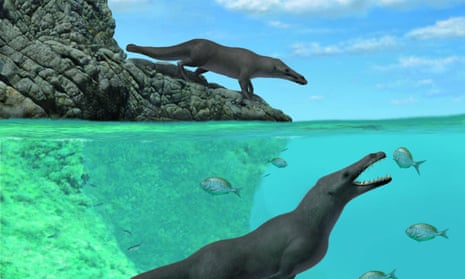Whales used to live on land. This fact never ceases to amaze me. Even though every living species of cetacean – from the immense blue whale to the river dolphins of the Amazon basin – is entirely aquatic, there were times when the word “whale” applied entirely to amphibious, crocodile-like beasts that splashed around at the water’s edge. This week, paleontologists named another.
Peregocetus pacificus – as named by a seven-strong paleontologist team led by Olivier Lambert – is a roughly 42m-year-old mammal that was excavated from the bed of an ancient ocean now preserved in Peru. The prehistoric swimmer wouldn’t have looked like any whale we’re familiar with today. This was a whale that still had arms and legs, the firm attachment of the hips to the spine and flattened toe-tips indicating that Peregocetus was an amphibious creature capable of strutting along the beach. Yet conspicuous expansions to the tailbones of Peregocetus are reminiscent of living mammals, such as otters, that swim with an up-and-down, undulating motion. This was an Eocene preview of the way modern whales move, different from the side-to-side swish of most fish.
Similar fossil whales, such as Maiacetus and Rodhocetus from Pakistan, have been found before. In fact, over the past four decades, paleontologists have uncovered a vast array of early whales that together document how a phylogenetic spray of early amphibious species became at home in the water and set up the evolution of today’s porpoises and humpbacks. But there are two points that make Peregocetus stand out.
The first, Lambert and colleagues point out, is where Peregocetus was found. This early whale wasn’t discovered in ancient Asia, like many others, but in South America. It’s the first of its kind to be found on the continent, and from the Pacific side, at that. This is something of a surprise. Clearly whales were eminently seaworthy long before they became more streamlined and lost their hindlimbs. Finds such as Peregocetus, as well as the related Georgiacetus from North America, indicate that walking whales were capable of crossing entire oceans.
But, more importantly, Peregocetus is a reminder of what wonders still await us in the fossil record. Let’s take the whale tale back to Charles Darwin. In 1859, as we well know, Darwin made his grand argument for dramatic biological transformation in On the Origin of Species. He gathered all the evidence he could, but the fossil record offered a bit of a problem. He even named one of the chapters On the Imperfection of the Geological Record. From our modern perspective, this might seem like a cop-out. But this was actually a wise move, and it anticipated discoveries just like Peregocetus.
Some geologists of the 19th century assumed they had the story of Earth’s history mostly sewn up. The strata of Europe were assumed to be well-mapped, the fossil record adequately sampled, whatever was found on their home turf to be much the same elsewhere in the world. But Darwin, following the lead of his mentor Charles Lyell, pointed out that this was ridiculous. The fossil record was a vast unknown, as inscrutable as the ocean depths themselves.
Trying to arrange a convincing series of transitional forms out of such incomplete evidence would have only set Darwin up to be contradicted as explorations continued. And even when species that could be taken as a confirmation of evolution by natural selection started to turn up, Darwin offered a different perspective. After the famous first bird Archaeopteryx was found in 1861, showing a mishmash of bird and reptile traits, Darwin didn’t crow about his perceptiveness. Instead, in the fourth edition of Origin, published in 1866, Darwin wrote that an organism with striking transitional features highlighted how much was left to find. “Hardly any recent discovery shows more forcibly than this how little we as yet know of the former inhabitants of the world,” Darwin wrote.
Peregocetus is another such creature, standing in our fossiliferous imagination with its hind feet on the land and front paws in the water. The whale certainly adds to our understanding of how and when cetaceans took to the seas, but the most powerful fact of all is simply that such an unusual and unexpected creature existed. Over a century and a half after On the Origin of Species hit shelves, we are still becoming acquainted with the fantastic organisms who called this planet home long, long before us, when our own ancestors could have no idea that they would give rise to such an inquisitive sort of primate. I simply can’t wait to see what turns up next.
